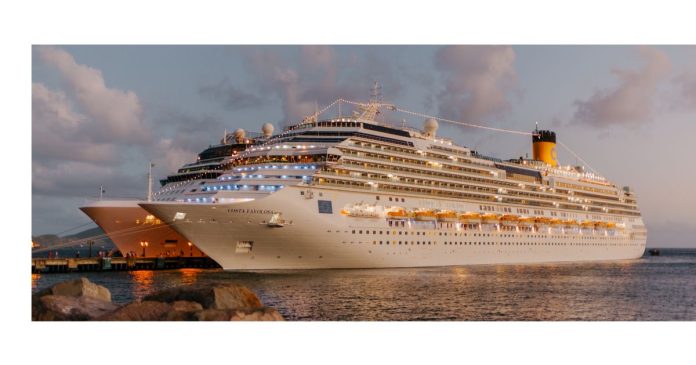When we think about the RMS Titanic, the first thing that comes to mind is its legendary voyage and tragic sinking. Built in the early 20th century, the Titanic was considered a marvel of engineering at the time. Its immense size, luxurious amenities, and cutting-edge technology made it one of the most talked-about ships of its era. Fast forward over a century, and modern-day cruise ships have evolved in ways that would have been unimaginable to those aboard the Titanic. But how does the Titanic stack up when compared to today’s floating cities Size and Capacity
1. Size and Capacity
One of the most striking differences between the Titanic and modern cruise ships is size. The Titanic, when it set sail in 1912, was the largest ship in the world, measuring 882 feet (269 meters) in length and weighing 46,328 tons. It could carry 2,224 passengers and crew members.
Today, cruise ships are even larger. For instance, the Symphony of the Seas, one of the largest cruise ships in the world, measures 1,184 feet (360 meters) in length and weighs a staggering 228,000 tons—more than four times the Titanic’s weight. Modern cruise ships can accommodate over 6,000 passengers, with up to 2,000 crew members, making them true floating resorts. The Titanic, by comparison, seems small, and its capacity is a fraction of what modern vessels can handle.
2. Technology and Safety Features
Titanic was equipped with the latest technology of its time. For example, it had a Marconi wireless telegraph system for communication, which was revolutionary for its era. However, it lacked many of the safety features we take for granted today. Most notably, the Titanic did not carry enough lifeboats for all its passengers, a fatal flaw that contributed to the disaster after it struck an iceberg.
In stark contrast, modern cruise ships are designed with state-of-the-art technology and an emphasis on passenger safety. Ships today are equipped with multiple layers of safety measures, such as fire detection systems, advanced navigation equipment, and real-time weather monitoring. Most importantly, modern ships are required to have enough lifeboats for everyone on board, and strict safety drills are conducted to ensure passengers know what to do in an emergency.
3. Comfort and Luxury
The Titanic was a symbol of luxury during its time. The ship featured lavish interiors, including grand dining rooms, luxurious suites, and even a Turkish bath. The first-class passengers were treated to unparalleled luxury, with amenities like a squash court, a swimming pool, and a grand staircase that has since become iconic.
Modern cruise ships have taken luxury to an entirely new level. Today’s vessels offer a variety of amenities, from multiple fine dining restaurants to spacious spas, water parks, Broadway-style shows, and even zip lines. The size and range of accommodations on modern cruise ships are unparalleled, with rooms ranging from basic interior cabins to opulent penthouses with balconies offering breathtaking ocean views. Passengers can enjoy every type of experience imaginable, from the relaxation of infinity pools to the excitement of virtual reality arcades and go-kart tracks.
4. Speed and Fuel Efficiency
The Titanic was powered by steam engines that could propel it at a maximum speed of around 24 knots (28 miles per hour). While this was impressive at the time, modern cruise ships are significantly faster and more fuel-efficient. For instance, many of today’s cruise ships can reach speeds of 30 knots or more, thanks to more advanced propulsion systems.
In addition, today’s ships often incorporate more sustainable technologies. Many cruise lines are investing in hybrid or LNG (liquefied natural gas) engines to reduce emissions, and some are even exploring options like fuel cells and solar panels to lessen their environmental impact.
5. Entertainment and Leisure
Titanic passengers enjoyed fine dining and entertainment, including orchestras and movie screenings. But compared to modern ships, the entertainment options were quite limited. The Titanic’s ballroom and smoking rooms were the height of sophistication for its time, but it lacked the wide variety of activities we now expect from cruise vacations.
Today’s cruise ships are packed with entertainment options to cater to every age group and interest. Passengers can enjoy Broadway shows, casinos, comedy clubs, themed parties, and numerous outdoor activities. Some ships even offer themed cruises, with activities ranging from yoga and meditation workshops to culinary experiences and live concerts.
6. Environmental Concerns
One area where the Titanic’s design falls short is its environmental consideration. Given the time period, there was little thought given to the ecological impact of ocean liners. Today, cruise lines are under increasing pressure to reduce their environmental footprint. Modern cruise ships are built with eco-friendly technologies in mind, including waste management systems, ballast water treatment, and energy-efficient lighting and air conditioning. While cruise ships are still under scrutiny for their environmental impact, the industry has made significant strides in recent years.
Conclusion
While the Titanic remains an enduring symbol of luxury and tragedy, the advancements in ship design, technology, and passenger experience over the past century are nothing short of astounding. Modern cruise ships are far larger, safer, and more comfortable than their early 20th-century predecessors. With their advanced technology, increased focus on safety, and array of entertainment options, today’s cruise ships are truly floating resorts that cater to the needs and desires of millions of passengers every year. The Titanic may have been a marvel of its time, but today’s cruise ships have truly redefined what is possible on the high seas.



